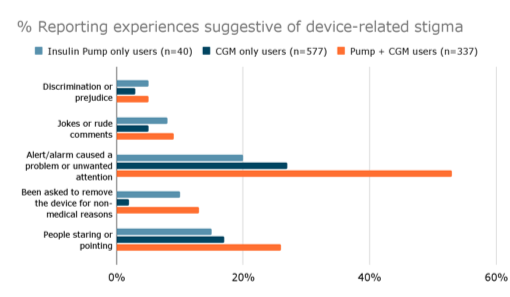Is There a Connection Between Diabetes Stigma and Device Use?
By Matthew Garza
 New research from diaTribe and market research firm, dQ&A, is looking to explore how diabetes stigma might be impacting people’s willingness to use insulin pumps and continuous glucose monitors.
New research from diaTribe and market research firm, dQ&A, is looking to explore how diabetes stigma might be impacting people’s willingness to use insulin pumps and continuous glucose monitors.
Diabetes Stigma – the exclusion, prejudice, shame, self-blame, and self-judgment that people with diabetes unfairly experience as a result of their condition – impacts so many aspects of life with diabetes. But does diabetes stigma influence whether a person uses certain diabetes devices like insulin pumps and continuous glucose monitors (CGM)? Or does it influence how they use them?
At the 2023 Advanced Technologies and Therapeutics in Diabetes conference, in Berlin Germany, as diaTribe’s Stigma program manager, I presented early data from a research study that sought to answer those questions.
diaTribe collaborated with the dStigmatize Research Group and the diabetes marketing research firm, dQ&A,to conduct a survey of 595 people with type 1 diabetes and 948 people with type 2 diabetes using the dQ&A U.S. Patient Panel. This survey’s goal was to explore the relationships between diabetes stigma and diabetes technology adoption and use.
The majority of the participants – regardless of diabetes type or which devices they used – believe that diabetes comes with social stigma in the US. This sentiment was shared by 79% of those surveyed with type 1 diabetes, 70% of those with type 2 diabetes who use insulin, and 64% of those with type 2 diabetes who do not use insulin.
The data also showed that for roughly one in five participants, diabetes stigma had at least a modest negative impact on their willingness to use one of these devices. This was specifically in people who did not currently use an insulin pump or CGM.

And for those study participants who were already using at least one of these devices, many reported at least one instance of a device-related stigmatizing experience. These experiences included discrimination or prejudice, jokes or rude comments, unwanted attention caused by alerts or alarms, staring and pointing, and being asked to remove the device for a non-medical reason.
More of the data from this study will be published in the future, but for now these results highlight that there is a complex relationship linking diabetes stigma and device use and strategies to reduce this stigma are needed.
No one who uses these devices should feel judged, ashamed, or isolated because of them. And people shouldn’t be afraid to adopt these devices because they make a person’s diabetes more visible. By reducing diabetes stigma, it may help remove at least one barrier that prevents people from accessing and using these helpful tools.
To learn more about diabetes stigma research just like this study, visit the dStigmatize Research Resources.








